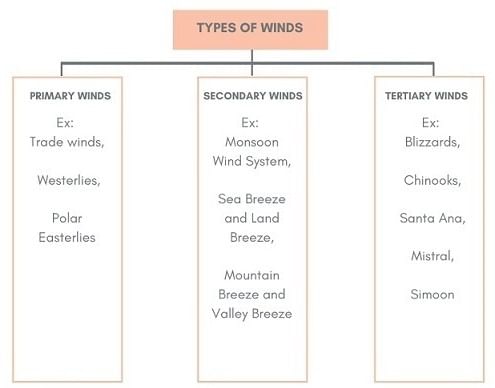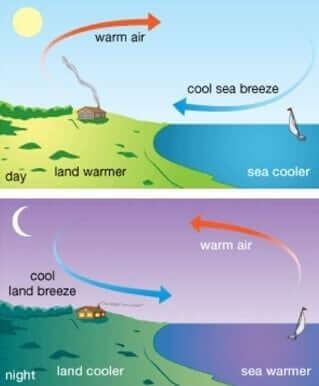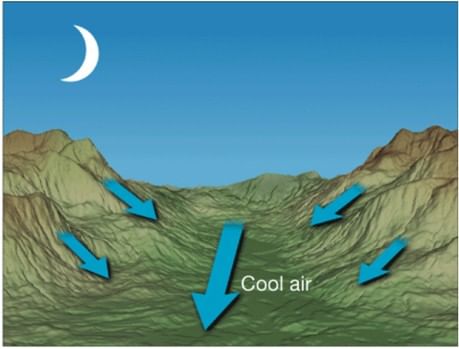UPSC Exam > UPSC Notes > Geography for UPSC CSE > Winds & Wind Types
Winds & Wind Types | Geography for UPSC CSE PDF Download
| Table of contents |

|
| Introduction |

|
| Primary Winds or Prevailing Winds or Permanent Winds |

|
| Secondary Winds or Periodic Winds |

|
| Tertiary Winds or Local Winds |

|
| Table of Major Local Wind Systems |

|
Introduction
The wind in simple terms is the horizontal movement of Air. This horizontal movement is caused by differences in air pressure within our atmosphere. Wind under high pressure moves toward areas of low pressure. In this article, we will learn about the Types Of Wind.

Types of Wind

➤ Permanent winds or Primary winds or Prevailing winds or Planetary Winds
- The trade winds, westerlies and easterlies.
➤ Secondary or Periodic Winds
- Seasonal winds: These winds change their direction in different seasons—for example, monsoons in India.
- Periodic winds: Land and sea breeze, mountain, and valley breeze.
➤ Local winds
- These blow only during a particular period of the day or year in a small area.
- Winds like Loo, Mistral, Foehn, Bora.Question for Winds & Wind TypesTry yourself:Which of the following wind is not a primary wind?View Solution
Primary Winds or Prevailing Winds or Permanent Winds
- These are the planetary winds which blow extensively over continents and oceans.
- The two most well- understood and significant winds for climate and human activities are trade winds and westerly winds.
Trade Winds
- The trade winds are those blowing from the sub-tropical high-pressure areas towards the equatorial low-pressure belt.
- Therefore, these are confined to a region between 30°N and 30°S throughout the earth’s surface.
- They flow as the north-eastern trades in the northern hemisphere and the south-eastern trades in the southern hemisphere.
- These Winds are called trade winds because they helped the sea merchants sail their ships as their (of trade winds) direction remains constant and regular.
- This deflection in their ideally expected north-south direction is explained based on Coriolis force and Farrel’s law.
- According to Ferrell’s law, winds are deflected to the right in the northern hemisphere and to the left in the southern hemisphere.
- Trade winds are descending and stable in areas of their origin (sub-tropical high-pressure belt), and as they reach the equator, they become humid and warmer after picking up moisture on their way.
- The trade winds from two hemispheres meet at the equator, and due to convergence they rise and cause heavy rainfall.
- The eastern parts of the trade winds associated with the cool ocean currents are drier and more stable than the ocean's western parts.

Westerlies
- The westerlies are the winds blowing from the subtropical high-pressure belts (30°-35°) towards the sub-polar low-pressure belts (60°-65°) in both hemispheres.
- They blow from southwest to north-east in the northern hemisphere and north-west to south-east in the southern hemisphere.
- The westerlies of the southern hemisphere are stronger and persistent due to the vast expanse of water. In contrast, those of the northern hemisphere is irregular because of the uneven relief of vast land-masses.
- Because of the land's dominance in the northern hemisphere, the westerlies become more complex and complicated and become less effective during the summer seasons and more vigorous during the winter season.
- These westerlies bring much precipitation in the continents' western parts (Example - north-west European coasts) because they pick up much moisture while passing over the vast stretches of the oceans.
- The westerlies become more vigorous in the southern hemisphere because of a lack of land and oceans' dominance. Their velocity increases southward, and they become stormy. They are also associated with boisterous gales.
- The westerlies are best developed between 40° and 65°S latitudes. These latitudes are often called Roaring Forties, Furious Fifties, and Shrieking Sixties – dreaded terms for sailors.
- The poleward boundary of the westerlies is highly fluctuating. There are many seasonal and short-term fluctuations. These winds produce wet spells and variability in weather.
Polar Easterlies
- The Polar easterlies are dry, cold prevailing winds blowing from north-east to south-west direction in Northern Hemisphere and south-east to the north-west in Southern Hemisphere.
- They blow from the polar high-pressure areas of the sub-polar lows. Question for Winds & Wind TypesTry yourself:Roaring forties are theView Solution
Secondary Winds or Periodic Winds
- These winds change their direction with change in season.
- Monsoons are the best example of large-scale modification of the planetary wind system.
- Other examples of periodic winds include land and sea breeze, mountain and valley breeze, cyclones and anticyclones, and air masses.
Monsoons
- Monsoons were traditionally explained as land and sea breezes on a large scale. Thus, they were considered a convectional circulation on a giant scale.
- The monsoons are characterised by seasonal reversal of wind direction.
- During summer, the southern hemisphere's trade winds are pulled northwards by an apparent northward movement of the sun and by an intense low-pressure core in the north-west of the Indian subcontinent.
- While crossing the equator, these winds get deflected to their right under the effect of Coriolis force.
- These winds now approach the Asian landmass as south-west monsoons. Since they travel a long distance over a vast expanse of water, by the time they reach the south-western coast of India, they are over-saturated with moisture and cause heavy rainfall in India and neighbouring countries.
- These conditions are reversed during winter, and a high-pressure core is created to the north of the Indian subcontinent. Divergent winds are produced by this anticyclonic movement which travels southwards towards the equator.
- This movement is enhanced by the apparent southward movement of the sun. These are north-east or winter monsoons which are responsible for some precipitation along the east coast of India.
- The monsoon winds flow over India, Pakistan, Bangladesh, Myanmar (Burma), Sri Lanka, the Arabian Sea, Bay of Bengal, southeastern Asia, northern Australia, China and
- Outside India, in the eastern Asiatic countries, such as China and Japan, the winter monsoon is stronger than the summer monsoon. (we will study about monsoons in detail while studying Indian Climate).
Land Breeze and Sea Breeze
- The land and sea absorb and transfer heat differently. During the day the land heats up faster and becomes warmer than the sea.
- Therefore, the air rises over the land, giving rise to a low-pressure area, whereas the sea is relatively cool and the pressure oversea is relatively high. Thus, the pressure gradient from sea to land is created, and the wind blows from the sea to the land as the sea breeze.
- At night the reversal of condition takes place. The land loses heat faster and is cooler than the sea. The pressure gradient is from the land to the sea and hence land breeze results.

Valley Breeze and Mountain Breeze
- In mountainous regions, during the day the slopes get heated up, and air moves upslope and to fill the resulting gap, the air from the valley blows up the valley.
- This wind is known as the valley breeze. During the night the slopes get cooled, and the dense air descends into the valley as the mountain wind.
- The cool air, of the high plateaus and ice fields draining into the valley, is called katabatic wind.
- Another type of warm wind (katabatic wind) occurs on the leeward side of the mountain ranges.
- The moisture in these winds, while crossing the mountain ranges condenses and precipitate. When it descends the slope's leeward side, the dry air gets warmed up by the adiabatic process. This dry air may melt the snow in a short time.


Tertiary Winds or Local Winds
- Local differences in temperature and pressure produce local winds.
- Such winds are local in extent and are confined to the lowest levels of the troposphere. Some examples of local winds are discussed below.
Loo
- Harmful Wind
- In the plains of northern India and Pakistan, sometimes a scorching and dry wind blows from the west in May and June, usually in the afternoons. It is known as Its temperature invariably ranges between 45°C and 50°C. It may cause sunstroke to people.
Foehn or Fohn
- Beneficial Wind
- Foehn is a hot wind of local importance in the Alps. It is a strong, gusty, dry and warm wind which develops on the leeward side of a mountain range. As the windward side takes away whatever moisture there is in the incoming wind in the form of orographic precipitation, the air that descends on the leeward side is dry and warm (Katabatic Wind).
- The temperature of the wind varies between 15°C and 20°C. The wind helps animal grazing by melting snow and aids the ripening of grapes.
Chinook
- Beneficial Wind
- A foehn like winds in USA and Canada move down the west slopes of the Rockies and are known as
- It is beneficial to ranchers east of the Rockies as it keeps the grasslands clear of snow during winter.Question for Winds & Wind TypesTry yourself:Which law states that winds in northern hemisphere go right and left in southern hemisphereView Solution
Mistral
- Harmful Wind
- Mistral is one of the local names given to such winds that blow from France's Alps towards the Mediterranean Sea.
- It is channelled through the Rhine valley. It is very cold and dry at high speed.
- It brings blizzards into southern France.
Sirocco
- Harmful Wind
- Sirocco is a Mediterranean wind that comes from the Sahara and reaches hurricane speeds in North Africa and Southern Europe.
- It arises from a warm, dry, tropical air mass pulled northward by low-pressure cells moving eastward across the Mediterranean Sea, with the wind originating in the Arabian or Sahara deserts. The hotter, drier continental air mixes with the cooler, wetter air of the maritime cyclone, and the counter-clockwise circulation of the low propels the mixed air across the southern coasts of Europe.
- The Sirocco causes dusty dry conditions along the northern coast of Africa, storms in the Mediterranean Sea, and cool, wet weather in Europe.
Table of Major Local Wind Systems

How is Wind Measured?
The wind has speed as well as direction, to measure this parameter, two different devices are used:
- Anemometers
- Wind vanes
Anemometers – is used for measuring the speed of the wind.
Wind vanes – is used for determining the direction of the wind.
Causes of Wind
The main cause of generation of wind is the uneven heating of two regions.
Examples:
- Uneven heating between land and sea
- Uneven heating between equator and pole
The document Winds & Wind Types | Geography for UPSC CSE is a part of the UPSC Course Geography for UPSC CSE.
All you need of UPSC at this link: UPSC
|
269 videos|870 docs|231 tests
|
FAQs on Winds & Wind Types - Geography for UPSC CSE
| 1. What are primary winds and how do they differ from secondary winds? |  |
Ans.Primary winds, also known as prevailing or permanent winds, are large-scale wind patterns that blow consistently throughout the year due to the Earth's rotation and differences in temperature and pressure. In contrast, secondary winds, or periodic winds, are seasonal or temporary winds that occur due to specific weather conditions, such as monsoons or trade winds that change direction with the seasons.
| 2. Can you explain what tertiary winds are and provide examples? |  |
Ans.Tertiary winds, or local winds, are winds that occur in specific areas and are influenced by local geography, such as mountains, valleys, and bodies of water. Examples include sea breezes, land breezes, and mountain valley breezes, which can vary greatly in strength and direction depending on the time of day and local conditions.
| 3. What factors influence the direction and strength of primary winds? |  |
Ans.The direction and strength of primary winds are influenced by several factors, including the Earth's rotation (Coriolis effect), temperature differences between the equator and the poles, the distribution of land and water, and the presence of high and low-pressure systems. These factors create predictable wind patterns that circulate around the planet.
| 4. How do local wind systems interact with primary and secondary winds? |  |
Ans.Local wind systems, or tertiary winds, can interact with primary and secondary winds by altering their direction and intensity. For example, local topography can channel or block larger wind patterns, causing changes in weather conditions. Additionally, local winds can enhance or diminish the effects of prevailing winds, leading to variations in temperature and precipitation in a given area.
| 5. What are some major local wind systems and their characteristics? |  |
Ans.Major local wind systems include the Santa Ana winds in Southern California, which are dry and warm, and the Mistral winds in France, which are cold and dry. Other examples are the Föhn winds in the Alps, which are warm and dry, and the Sirocco winds from the Sahara, which bring hot and dusty conditions to Southern Europe. Each of these local wind systems has unique characteristics that affect the local climate and weather patterns.
Related Searches
















